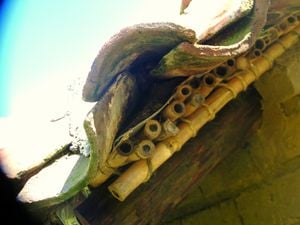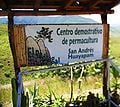No edit summary |
Sophivorus (talk | contribs) m (Rename "affiliations" parameter to "organizations", to unify terminology throughout Appropedia) |
||
| (28 intermediate revisions by 7 users not shown) | |||
| Line 1: | Line 1: | ||
[[File:100 2171.JPG|thumb]] | |||
{{Project data | |||
| status = Deployed | |||
| completed = 2010 | |||
| instance-of = Tetrapack ceiling insulation | |||
| location = Mexico, Oaxaca | |||
}} | |||
Traditionally in many parts of Oaxaca and especially in the central valleys, roofs were made from successive layers of reeds, clay and tile hoisted on thick log supports. The system is excellent in terms of insulation and wind resistance, however it can encourage the proliferation of pests and needs to be regularly maintained and replaced. In response people have started to use cardboard, tar, and cement instead of clay for their roofing.<ref>Lopex, Laura. L., Esteva, Gustavo., Consejo, Juan J., Padilla, Eugenio., Robles, Marcela., and Alejandre, Virginia. Defensa Ecologica: Manual de Tecnicas. 2a. edition. Oaxaca, 1998.</ref> | |||
A cheap and effective alternative is the use of milk containers or other liquids, known commercially as "tetra pack." These containers are waterproof and are composed of cardboard pressed to plastic and aluminum, making them unrecyclabe in most places. Though they can not be recycled they can be reused as great insulation, as well as resistant and durable material for roofing and other building needs. Reusing this material not only helps your building, it helps remove another material from the waste stream and overloaded landfills.<ref>Lopex, Laura. L., Esteva, Gustavo., Consejo, Juan J., Padilla, Eugenio., Robles, Marcela., and Alejandre, Virginia. Defensa Ecologica: Manual de Tecnicas. 2a. edition. Oaxaca, 1998.</ref> | |||
<gallery> | |||
File:100 2078.JPG | |||
File:100 2175.JPG | |||
File:100 2171.JPG | |||
File:100 2112.JPG | |||
File:100 2118.JPG | |||
File:100 2293.JPG | |||
</gallery> | |||
== | == Background == | ||
This is one project in a series of soil conservation, groundwater recharge, and farming demonstration projects at the [[Permaculture Demonstration Center in San Andres Huayapam]],Mexico called '''Pedregal'''. | |||
== | == How to use Tetra Pack for Roofing == | ||
In order to use these containers they should be washed and cut along the seam until it can be laid down as a flat box. Once it has been flattened you can bind two together by overlapping the edges a few inches and stapling them together. When you have a full mat of connected tetra pack place the tetra pack mat on top of the reed or bamboo mat woven together with rope. You do not need to adhere the tetra pack to the reed mat if you place spanish roofing tiles on top. Do place a bit of cement or clay between the tetra pack and the roofing tiles. This insulation system can be combined with other roofing materials as well.<ref>Lopex, Laura. L., Esteva, Gustavo., Consejo, Juan J., Padilla, Eugenio., Robles, Marcela., and Alejandre, Virginia. Defensa Ecologica: Manual de Tecnicas. 2a. edition. Oaxaca, 1998.</ref> | |||
In order to use these containers they should be washed and cut along the seam until it can be laid down as a flat box. | |||
== References == | == References == | ||
<references /> | <references /> | ||
{{Page data | |||
| keywords = ceiling, permaculture, recycled, tetra pack | |||
| sdg = SDG11 Sustainable cities and communities, SDG12 Responsible consumption and production | |||
| published = 2010 | |||
| organizations = Permaculture Demonstration Center in San Andres Huayapam | |||
| license = CC-BY-SA-3.0 | |||
| language = en | |||
}} | |||
[[Category:Construction and materials]] | |||
[[Category:Permaculture]] | |||
Latest revision as of 17:43, 29 January 2024

Traditionally in many parts of Oaxaca and especially in the central valleys, roofs were made from successive layers of reeds, clay and tile hoisted on thick log supports. The system is excellent in terms of insulation and wind resistance, however it can encourage the proliferation of pests and needs to be regularly maintained and replaced. In response people have started to use cardboard, tar, and cement instead of clay for their roofing.[1]
A cheap and effective alternative is the use of milk containers or other liquids, known commercially as "tetra pack." These containers are waterproof and are composed of cardboard pressed to plastic and aluminum, making them unrecyclabe in most places. Though they can not be recycled they can be reused as great insulation, as well as resistant and durable material for roofing and other building needs. Reusing this material not only helps your building, it helps remove another material from the waste stream and overloaded landfills.[2]
Background[edit | edit source]
This is one project in a series of soil conservation, groundwater recharge, and farming demonstration projects at the Permaculture Demonstration Center in San Andres Huayapam,Mexico called Pedregal.
How to use Tetra Pack for Roofing[edit | edit source]
In order to use these containers they should be washed and cut along the seam until it can be laid down as a flat box. Once it has been flattened you can bind two together by overlapping the edges a few inches and stapling them together. When you have a full mat of connected tetra pack place the tetra pack mat on top of the reed or bamboo mat woven together with rope. You do not need to adhere the tetra pack to the reed mat if you place spanish roofing tiles on top. Do place a bit of cement or clay between the tetra pack and the roofing tiles. This insulation system can be combined with other roofing materials as well.[3]
References[edit | edit source]
- ↑ Lopex, Laura. L., Esteva, Gustavo., Consejo, Juan J., Padilla, Eugenio., Robles, Marcela., and Alejandre, Virginia. Defensa Ecologica: Manual de Tecnicas. 2a. edition. Oaxaca, 1998.
- ↑ Lopex, Laura. L., Esteva, Gustavo., Consejo, Juan J., Padilla, Eugenio., Robles, Marcela., and Alejandre, Virginia. Defensa Ecologica: Manual de Tecnicas. 2a. edition. Oaxaca, 1998.
- ↑ Lopex, Laura. L., Esteva, Gustavo., Consejo, Juan J., Padilla, Eugenio., Robles, Marcela., and Alejandre, Virginia. Defensa Ecologica: Manual de Tecnicas. 2a. edition. Oaxaca, 1998.





